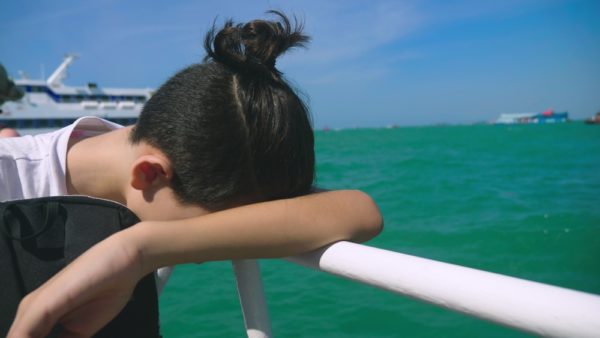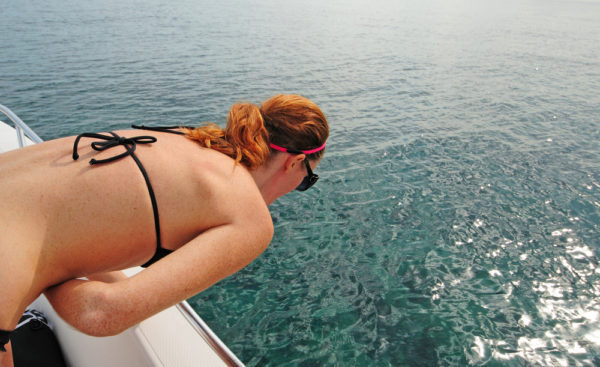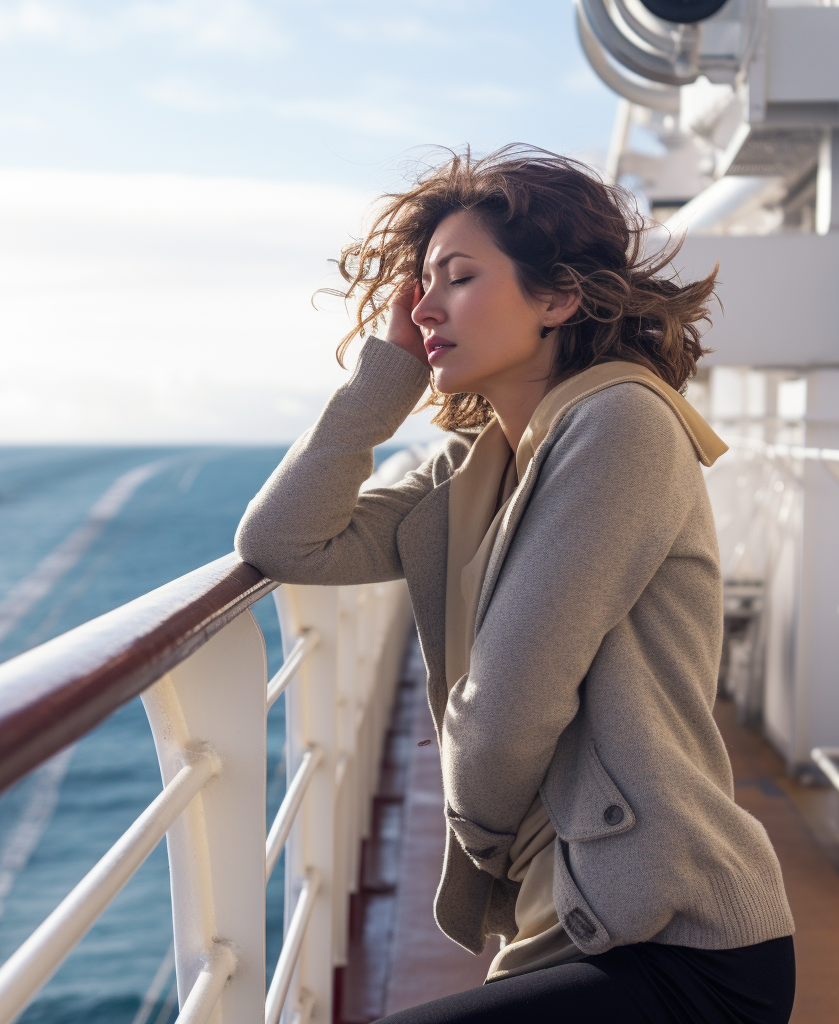Motion sickness doesn’t have to be an obstacle to sailing on a family cruise. Learn the best ways to avoid seasickness on a cruise.

Every time I rave about the magic of family cruising, there’s one concern that consistently floats to the surface: the dread of seasickness. Many first-time cruisers, whether they’ve experienced motion sickness before or not, harbor fears that the gentle sway of the ship might leave them or their little ones feeling queasy. Yet, cruising can be such a delightful experience if you’re prepared.
These are obviously legitimate concerns. Motion sickness can easily turn what should be a relaxing dream cruise vacation into a nightmare.
Find out what could cause you or your family to experience seasickness while cruising. And, learn some simple strategies for avoiding seasickness, and also for addressing it, if it should occur.
Related Content: 63 First Time Cruise Tips That Will Make Your Family Cruise Terrific
What Causes Seasickness On Cruises?
Anyone can get motion sickness under certain circumstances. The categories of people most at risk are relatively broad: children ages 5 to 12; older adults; women, particularly if menstruating; and migraine sufferers. Interestingly, children under the age of 2 don’t seem to be that affected.
According to ocean experts, seasickness arises when your brain perceives a conflict between some key senses. Your inner ear controls your balance. It will register when your body is out of balance, such as when you’re standing on a boat rocking back and forth. But, when you’re on a boat, depending on what you’re looking at, your eyes are probably registering a relatively stable scene.
This disconnect between what your senses perceive makes your brain unhappy and triggers the release of certain stress-related hormones that can lead to symptoms commonly associated with seasickness.
Strategies To Avoid Seasickness On A Cruise

1. Choose the Right Cruise Ship To Avoid Motion Sickness.
Selecting the right cruise can help you prevent motion sickness.
Essentially, to lessen the chances of you or your kids experiencing motion sickness, you want to be on a sailing that is not rocky. Thus, the first thing to do is select one of the newer mega-ships because they have state-of-the-art stabilizers that control the types of ship swaying that contribute to disequilibrium.
Since so many of these have launched in the past few years across almost all of the major cruise lines, this should not be a problem.
2. Select An Itinerary With Calmer Waters.
You also want to be strategic in selecting an itinerary. Select one that has less actual time out on the water, such as one that has many port days and minimal sea days. Or, similarly, one that has built-in “overnights” where the ship stays in port. You should avoid sailings that have more than one or two consecutive sea days.
Also, some seas are known to be particularly choppy at certain times of the year. For example, the Caribbean waters are generally smooth sailing. But, it’s a different story during hurricane season.
Similarly, certain Alaskan routes are known to have more calmer waters than others. Consulting with a travel agent can help you figure this one out.
This Page may contain affiliate links. Visit our Disclosures Page for more information.
3. Avoid Motion Sickness By Choosing the Right Cabin.
As with selecting a ship that is less likely to provide a rocky ride, you can select a stateroom that is also less likely to experience obvious rockiness. Think stability.
You know how, on a seesaw, the closer you are to the center, the less likely you are to feel the extreme swings of the seesaw motion? The same is true for a ship.
The farther away that you are from the center of the ship, the more likely you are to experience motion. So, to avoid getting seasick on a cruise, choose a mid-ship cabin.
Likewise, the higher up you go in the ship, the more likely you are to experience motion. So you should select a room that is as close to mid-ship as possible, and on a lower deck.
The ship rocking side to side, as it travels through the waves, causes most episodes of seasickness on cruises. The closer to the middle and the closer to the water line you are, the less movement you will experience.
Also, if there is a balcony stateroom that fits within your budget, grab it. Being able actually to see the horizon helps mitigate the queasiness from the ship’s movements. Having access to the fresh air also helps.
Related Content: Our Family Guide to Choosing a Cruise Cabin With Ease
4. Try One of Several Medical Options That Prevent Seasickness.
Not surprisingly, a variety of medications exist that can help prevent getting seasick on cruises. First, there are well-established prescription therapies that you can use to avoid seasickness. You should confer with your private physician about them. Some should be started a few days before you ever leave the shore, so you should plan early.
This would be the prudent strategy if you or a member of your family has a history of motion sickness. However, the prior circumstances that made someone sick do not necessarily mean you will also experience motion sickness on a large cruise ship.
Second, a variety of over-the-counter medications can also be effective at preventing seasickness. Antihistamines are known to be particularly effective.
Two popular medicines for motion sickness are Bonine and Dramamine. These are available over the counter at most drug stores and grocery stores, and you can also find them online.
A potential downside of these medications is that they can make you drowsy, but some non-drowsy versions are available as well. These medications work best if you take them before you start feeling seasick.
There are children’s versions of both of these medicines. (Since some kids are known to have unusual reactions to antihistamines (e.g., Benadryl), you should try this out at home first.)

5. Try Popular and Effective Non-Medical Treatments For Seasickness.
If you’re concerned about taking medication, or just want to have multiple options, several non-medical treatments also exist.
Wristbands
One popular solution is a Sea-Band wristband. You can often find these in one of the gift shops on board the ship. But you’ll almost certainly save money if you buy them in advance. (Note: Post-pandemic, some cruise lines now require visiting the ship’s medical clinic for all medicines, including OTC.)
This band uses the principles of acupressure to help curb motion-induced nausea and vomiting. You can find them in both adult and kid sizes.
I have traveled with several people who have used these bands and found them to be effective. These were people who were experiencing unpleasant symptoms before acquiring the band but were able to enjoy the rest of the cruise once they started wearing them. (By the way, in each of the instances I am thinking of, we were sailing during the height of hurricane season.)
Adhesive Patches
Another effective non-medical option that works for both adults and kids: seasick patches!
These patches offer a drug-free approach to handling motion sickness on cruise ships. You place them behind your ear or on your navel, and they work using menthol and herbal ingredients. Each patch is designed to last up to 24 hours.
The patches are waterproof and won’t make you drowsy, which is helpful if you want to enjoy your vacation without feeling tired. They’re safe for kids aged three and up. The pack includes 28 patches with individual wrapping.
A noteworthy fact: You can drink alcohol while using these patches. This makes them different from some other motion sickness products that warn against mixing with alcoholic beverages. This feature matters to people who want to enjoy drinks during their cruise or vacation without worrying about bad interactions.
6. Food & Beverages: What To Consume, What To Avoid.
A very popular and widely endorsed DIY remedy for seasickness is ginger root or variations on ginger such as ginger ale or candied ginger. And, saltines or other dry crackers also help many people combat that queasy feeling.
Certain aromas also can reportedly soothe symptoms of seasickness, so try aromatic teas that have scents of anise (licorice), basil, chamomile, or peppermint.
Also, increase your hydration by drinking lots of water.
Limit or eliminate alcohol consumption. Avoid or moderate consumption of high-fat, greasy, or excessively sugary foods.
7. Try An Earplug.
For some folks, using one earplug can help with motion sickness. The theory behind this is that by plugging only one ear, your brain realizes that whatever signals your ears are picking up are unreliable, and those ear signals will play less of a role in your brain’s processing of your environment.
The folks who endorse this strategy, also advise placing the earplug in the ear that corresponds to your non-dominant hand. So, folks who are right-handed should plug their left ear, and vice versa.
8. Avoid Extended Reading.
Reading can make potential seasick symptoms worse. Focusing your eyes on the words on a print or screen can magnify the discrepancy between what your ears are sensing and what your eyes are seeing. (Tip: Audiobooks can be a great option that allows you to still enjoy your vacation reading. Sign up for a 30-day free trial Audible subscription before you go, and download a few choice titles!)

9. Experts Say Positive Thinking Can Actually Prevent Getting Seasick.
Finally, never underestimate the power of mental suggestion and positive thinking. Experts say that sometimes, the fear of experiencing seasickness can actually cause someone to experience the symptoms. Also, according to the American Academy of Family Physicians, “discussing symptoms with others can exacerbate the condition.”
Assuming that’s true, you should be cautious about talking about potential seasickness excessively in advance of the cruise, particularly in front of your kids.
Also, some people have found (including NASA astronauts) that positive thinking and biofeedback exercises like controlled breathing and other relaxation techniques can help control motion sickness.
10. You Can Always Try Waiting It Out.
Under most circumstances, any seasickness on a cruise that you may experience will be temporary. According to experts, seasickness usually occurs within the first 24 hours after embarkation. Once your body has time to get used to the ship’s motion, the seasickness usually goes away.
It’s rare that passengers remain ill beyond the first couple of days at sea unless there are significant changes in the ship’s motion pattern, such as when the ship encounters very rough seas.
Closing Thoughts:
You don’t have to let a fear of motion sickness keep your family from going on a cruise. Motion sickness doesn’t have to ruin your cruise. Employing one or more of the above strategies should help you limit the occurrence of seasickness and the effect of its symptoms so that you can enjoy your time out on the ocean.

Elaine Warren
Founder & Crew Chief
Elaine founded this website after publishing the book The Family Cruise Companion’s Guide to Cruising With Kids. (Second edition recently released!) She has sailed on 45 cruises (and counting). She loves helping families navigate their way to an adventure-filled, fun, and memorable vacation.
Keep up with the latest cruise tips and insights! Follow us on Pinterest:
Last update on 2026-01-02 / Affiliate links / Images from Amazon Product Advertising API

